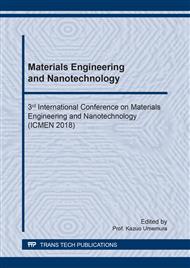p.98
p.105
p.110
p.116
p.121
p.126
p.136
p.142
p.151
Improving Conductivity Performance of Chitosan by Carboxymethylation Reaction: Synthesis and Characterization
Abstract:
Chitosan has been applied widely in electrical energy storage purposes like battery and fuel cell, as in electrolyte. This research purposed on improving compatibility chitosan as material for electrical energy storage by chemical reaction. Carboxymethylation reaction performed on chitosan to add carboxymethyl groups in either hydroxyl or amine sites or both. The substitution result could effect by optimizing in the ratio of reactants and reaction condition. Carboxymethylation process on chitosan will confirm by FTIR analysis and degree of carboxymethyl substitution can be calculated from 1H NMR. Its ionic conductivity will calculate from EIS. The highest degree of substitution obtained at 64.64%. This reaction had the ratio of chitosan:monochloroacetic acid about 1:6 (m/m) and was reacted in reflux system at 65°C. EIS analysis showed improvement of carboxymethyl chitosan’s conductivity where pure chitosan had 2.7 x 10-6 Scm-1 and CMC-IV had 2.7 x 10-5 Scm-1 at room temperature.
Info:
Periodical:
Pages:
121-125
Citation:
Online since:
October 2018
Authors:
Price:
Сopyright:
© 2018 Trans Tech Publications Ltd. All Rights Reserved
Share:
Citation:


